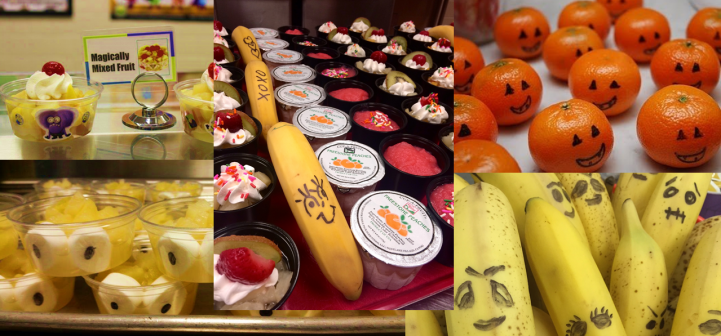
The results are in: Smarter Lunchrooms strategies can have a big impact on fruit and vegetable consumption — just ask the Food and Nutrition Services (FNS) Staff of the Martin County, FL School District! During the 2016/17 school year, Registered Dietitian and FNS Specialist Yvonne Potsko and FNS Director Laura Holmedal implemented a district-wide Smarter Lunchrooms initiative that resulted in greater excitement about eating healthy foods and increased consumption of fruits and vegetables.
The initiative began when the Martin County FNS team identified a problem needing a solution: students weren’t selecting fruits and veggies and many were being thrown away. Mrs. Holmedal and Mrs. Potsko created an action plan for elementary schools that targeted fresh fruit and vegetable offerings with select Smarter Lunchroom strategies and food art techniques.
To start, they engaged the UF/IFAS Extension Family Nutrition Program (SNAP-Ed in Florida) to conduct a Smarter Lunchrooms training for 22 cafeteria and FNS staff in October 2016. The training provided an overview of the Smarter Lunchrooms Movement and outlined specific, research-based strategies that can “nudge” students toward making healthier food choices in the lunchroom. The training was a crucial step in motivating cafeteria managers to take part in a district-wide Smarter Lunchrooms initiative.
Next, the FNS department provided cafeteria managers at the elementary level with inexpensive resources and tools to implement a variety of creative marketing strategies that would make selecting fruits and veggies the easy and fun choice. These low- and no-cost tools included:
- Online Food Art Photos: to give the managers ideas of how to creatively display fruits and veggies in enticing ways.
- Food-edible Markers: to draw attractive designs on fruit, including bananas and oranges. Some fun designs that managers used were smiley faces, cartoon characters, hearts (great for Valentine’s day), and jack o’ lantern faces on oranges for Halloween. The result of this initiative was that students began seeking out produce with food art and requested them by name: “Where are the Minions bananas today?”
- Mini Cookie Cutters: to cut fruit into fun shapes for a “magical fruit salad.”
- Pre-printed Food labels for fruits and veggies + label holders: Mrs. Potsko pre-printed and laminated food labels with creative and fun names, such as “Bouncy Bananas,” “Magically Mixed Fruit,” and “O’some Orange Slices.” The pre-printed labels took the guesswork and prep-work out of the process and made implementation of this strategy exceedingly simple for managers.
- Assorted Stickers: to place on fruits and veggies. The stickers became collectibles in the school!
- Garnishes: cherries and whipped cream made the cut fruit options look extra tasty.
The district’s efforts paid off! An analysis was conducted at one of the school sites that compared the amount of fresh produce sold the week before implementation to the week of the implementation. The analysis found an average increase of 62.8% for fruit and 13.8% for vegetables the week when the Smarter Lunchroom Strategies were in place. Additionally, district-wide elementary lunch participation increased by 6% and staff observed a decrease in plate waste.
These exciting results culminated in a USDA Annual Best Practices Award, which rewards outstanding practices in School Food Service Authorities and Schools! (School Food Service officials should contact their USDA state office for information on how to apply.) Martin County FNS will be expanding their Smarter Lunchroom program to middle and high schools during the 2017/2018 school year.
By following Martin County’s example, school districts, SNAP-Ed agencies, and partner organizations in any locale can collaborate to champion a successful Smarter Lunchrooms Movement. Some keys to success include central leadership from the FNS department, conducting a Smarter Lunchrooms training and brainstorming session for school food service staff, providing inexpensive tools and resources to cafeteria managers, and sharing photos of creative fruit and vegetable displays to serve as inspiration. The results speak for themselves!
Contributors
Angelika Schlanger, PhD, Regional Public Health Specialist, UF/IFAS Extension Family Nutrition Program
Resources
- Ideas for creative and descriptive food names and label templates can be found at SmarterLunchrooms.org
- Signs and other display materials, can also be found at SmarterLunchrooms.org
- Amazon, Oriental Training, restaurant supply stores, and other discount sites are great places to order inexpensive tools for Smarter Lunchrooms implementation, such as stickers, cookie cutters, label holders, colorful bowls, and fruit baskets/stands. Here are some of specific items that you may consider using:
- Food-edible markers: http://amzn.to/2tanRzs
- Mini cookie cutters: http://amzn.to/2tJVhHr
- Label holders: http://amzn.to/2uH9Wpq
- Minions stickers: http://amzn.to/2tNS73F
- Colorful bowls: http://amzn.to/2vs35xG
- Fruit Stands: https://www.webstaurantstore.com/tablecraft-fc1649-chrome-curved-fruit-basket-14-1-2-x-18/808FC1649.html
- To find out how your school or district Food Service Authority (FSA) can apply for a USDA Best Practices award, contact your state’s USDA office.
